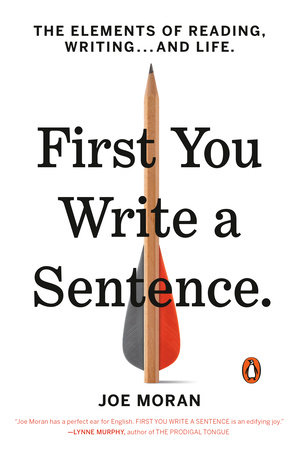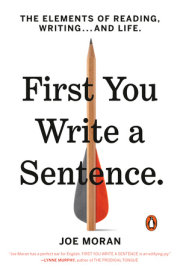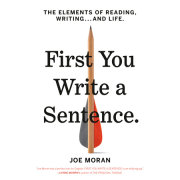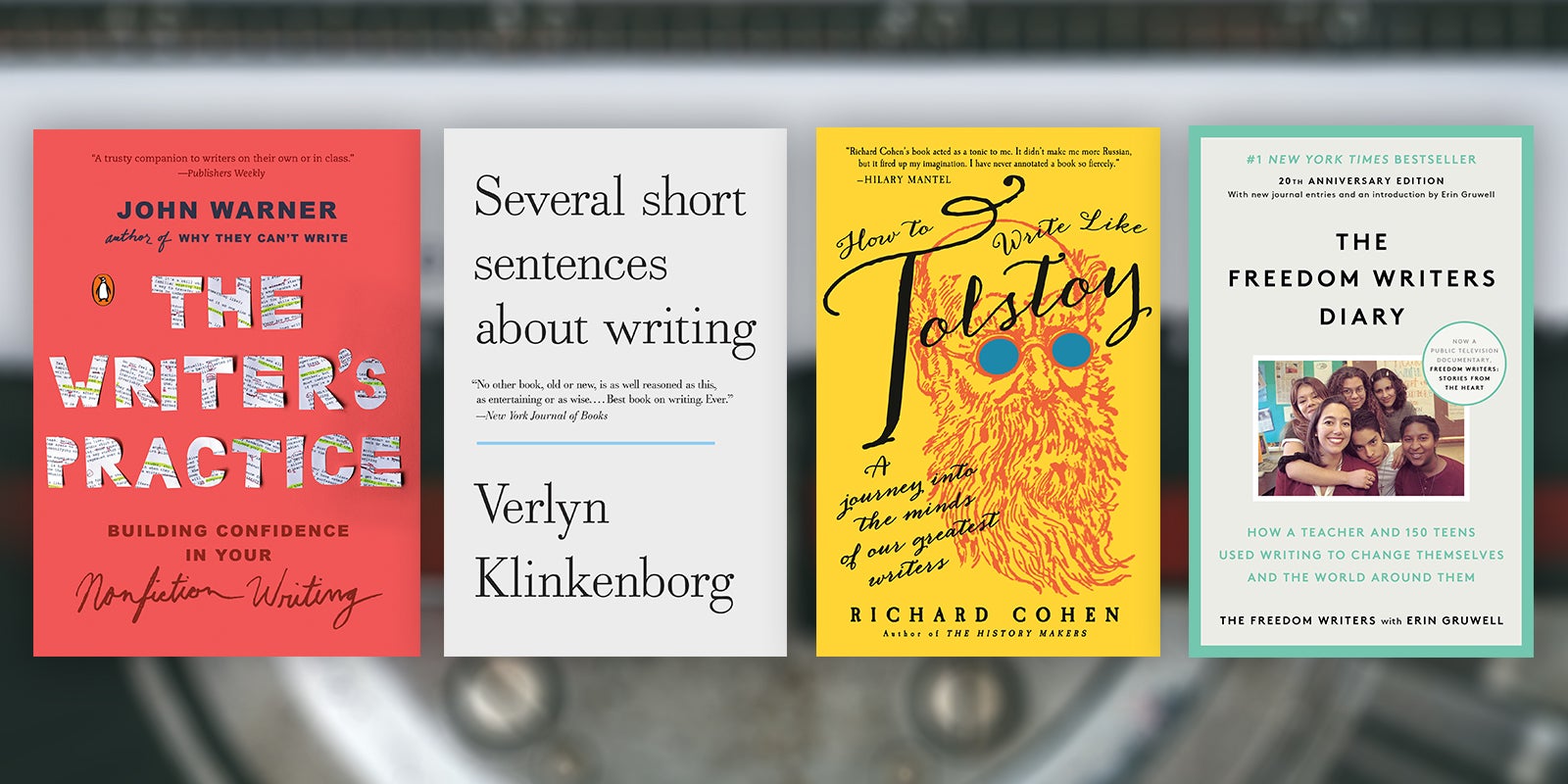1.A Pedant's ApologyOr why I wrote this bookFirst I write a sentence. I get a tickle of an idea for how the words might come together, like an angler feeling a tug on the rod's line. Then I sound out the sentence in my head. Then I tap it on my keyboard, trying to recall its shape. Then I look at it and say it aloud, to see if it sings. Then I tweak, rejig, shave off a syllable, swap a word for a phrase or a phrase for a word. Then I sit it next to other sentences to see how it behaves in company. And then I delete it all and start again.
If there were a pie chart that divided up my time on earth, the colored slice that covers writing sentences would be the biggest, apart from the one that covers the thing everyone does: sleeping. I don't count how much writing I have done each day, but if I did I wouldn't count words, I'd count sentences. Sentences are my core output, the little widgets I make in my workshop of words. It helps to think of it like this, as just cranking out a daily quota of sentences, instead of being a
writer, which feels like a claim that will need to be stamped and approved. I write maybe three and a half thousand sentences a year. Is this too many, or not enough, or about right? I have no idea. I write one sentence, then another, and repeat until done. I don't know when
done is.
Some writers claim to have sentences in their heads hollering to get out. Flaubert wrote that he was "itching" with them. These writers just seem to have a knack for putting words into right-seeming order, as if it were a skill as randomly allotted as being able to wiggle one's ears. Not me. But I can spot a good tune when I hear it. I know what a good sentence looks and sounds like, so that when I come across one in my own writing I have the good sense not to delete it but to try and replicate it. Having only minor gifts has its compensations. It has forced me to think hard about how words join up and why some sentences work better than others. A nightingale has no idea why such a bewitching noise emerges from its throat; a human nightingale impersonator must parse every note.
I may give more time to them than most people do, but we are all of us, of school age and older, in the sentences game. Sentences are our writing commons, the shared ground where every writer walks. A poet works with them, but so does the unsung author who came up with
Items trapped in doors cause delays or
Store in a cool, dry place. Every kind of writer writes in sentences. Even the most clueless or careless strew their writing with capital letters and full stops, in the hope that they will turn what lies between them into this universal currency. By learning to make sentences, we learn not just about writing but about everything. The sentence is where we make the briefest of senses out of this mad, beautiful, befuddling mess: life.
In 1940 a soon-to-retire Cambridge math don called G. H. Hardy published a defense of his life's work. His field was the purest form of mathematics, number theory, and his book was meant to be a mea culpa for spending his life on something of no practical use that few people would ever understand. In fact, although he called it
A Mathematician's Apology, it was not very apologetic.
Hardy declared that maths had given him his life's "one great permanent happiness," and that, when the world was immolating itself in war, it offered a consolingly parallel universe of spare, numbered beauty. Applied maths, the kind that could compute the dimensions of the Forth Bridge or the reach of a radio transmitter, he decried as "trivial." Real maths, he thought, bypassed the world in pursuit of pure abstraction. It was useful only rarely and never on purpose. Like Einstein, Hardy felt above all that equations should be beautiful. "A mathematician, like a painter or a poet," he wrote, "is a maker of patterns."
A mathematical equation and a written sentence have much in common. Both rely on symmetry and balance, often asserting a connection between the seemingly different. Both explain reality in as elegantly concise a form as they can. Both reduce randomness to inevitability, their equal signs or clauses falling into place with a rightness that renders the inchoate and incoherent suddenly clear. Both tell us something about the world outside themselves-but both also swim in their own kind of beauty.
Pure mathematicians, like Hardy, have long debated whether advances in their field are invented or discovered. Is an elegant equation a piece of human handiwork, or the unearthing of an eternal reality that was there before some fortunate human chanced upon it? The same question might be asked of an elegant sentence, which seems to sit somewhere in this Tom Tiddler's ground between invention and discovery. Like an elegant equation, it has floated free of its maker and feels inevitable. It came out of a single mind but now belongs to the world.
Fixating on how a sentence looks and sounds, finding the right fit between the thought you want to express and the form it fits inside, can seem as removed from the real world as G. H. Hardy's mathematics. More so, perhaps, because, as Hardy wrote, human languages die but numbers live forever. To care about sentences as Hardy did about math, you must feel about them the way that he felt about numbers. In other words, you must know that, even as they try to explain and account for the world, nothing lies behind them but their own artifice.
Hardy's book has been an unlikely inspiration for mine. For this is a book of sentences written in praise of writing sentences. I want it not to school but to hearten, embolden and galvanize the reader-who is almost always, in some way, a writer. I hope it will say something useful about how to write a sentence and put it alongside other sentences. But really it is about why it is worth taking pains over a sentence, in a world where everyone seems to be speaking at once and finishing each other's sentences for them.
A lesson works best when it doesn't feel like one, when it feels instead like an attempt to repay the favor that was once done to the teacher-in my case, by the writers of other sentences that have instructed me in and delighted me into writing my own. So this book is not a style guide, if that means a series of prescriptions and proscriptions. But perhaps it is a style guide by stealth: one that tries to show what it wants to teach, or to show instead of teaching.
I was going to call it
A Pedant's Apology-a mea culpa for spending my life worrying about something as small and minor- seeming as the sentence. But I am not sure I quite cut it as a pedant. Like most of my generation, my knowledge of grammar is a patchwork, sewn over many years and with thousands of holes in it.
I am still baffled by those sentence diagrams with the subject on the left and the verb on the right of a horizontal line, and modifiers veering off like motorway slip roads. However hard I try, I cannot link them in my head to actual sentences, the ones that are just a deceptively simple line of words. One of my sixth-form teachers told us that sentence diagrams were as vital to the study of sentences as skeletons were to a medical student studying anatomy. If she was right, then I will never be a doctor of writing. I scrabble my way through my own sentences on hunches and happenstance.
But then I remind myself that the English sentence belongs to everyone, not just those who like to police other people's use of it. I dislike writing advice that worries only about the sameness of surface features and that minds more about meticulousness than music. The literal meaning of
meticulous is "being careful out of fear." Fear feels like the wrong feeling with which to start making sentences. For me it is not the veneration of rules but care for word choice and order that counts. If you get those right then all the rest of it, from dangling modifiers to Oxford commas, will solve itself or cease to matter.
And yet they do say that poets are pedants in disguise (or is it the other way round?). Even poets with a shaky grip on grammar care about where a comma falls or a full stop comes to rest. They know that it adds not just to the meaning of a line but to its music. For those of us who cannot do number theory, the sentence might be as near as we ever get to orchestrating beauty. A modest beauty, perhaps, which is all a sentence can aim at, but beauty all the same-one that turns the everyday words everyone uses into hard little jewels that glint and gleam together. If this is pedantry, then I plead guilty.
No one can agree on what a sentence is. The safest definition is typographic. A sentence starts with a capital letter and ends with a full stop-except that some start with quote marks, and some end with question or exclamation marks, so that doesn't quite work. Let's try again. A sentence is the largest domain over which the rules of grammar have dominion. Thus it stands grammatically apart from the sentences around it. Except when it is a fragment that hangs over from the last sentence as an afterthought. Or that briefly sets a scene, like every sentence of the shipping forecast.
Occasional gales. Fog patches. Mainly moderate.A sentence is a small, sealed vessel for holding meaning. It delivers some news-an assertion, command or question-about the world. Every sentence needs a subject, which is a noun or noun phrase, and a predicate, which is just the bit of the sentence that isn't the subject and that must have a main verb. The subject is usually (but not always) what the sentence is about and the predicate is usually (but not always) what happens to the subject or what it is.
This [subject]
is a sentence [predicate]. A sentence must have a subject and a main verb, except when it leaves out one or both of them because their presence is implied. OK?
A sentence can be a single word, or it can stretch into infinity, because more words can be piled on to a main clause for ever. The Czech writer Bohumil Hrabal wrote a whole novel (
Dancing Lessons for the Advanced in Age) containing just one sentence. But he said that his comic sensibility was shaped by a short one he once read on a dry cleaner's receipt:
Some stains can be removed only by the destruction of the material itself. Marcel Proust, who in
The Captive wrote a 447-word sentence about a sofa, said that he wanted to "weave these long silks as I spin them" and to "encircle the truth with a single-even if long and sinuous-stroke." For Proust, a sentence traced an unbroken line of thought. Cutting it in two broke the line. Depending on its line of thought, a sentence can be a tiny shard of sense or a Proustian demi-world, brought to life and lit up with words.
For Henry David Thoreau, the sentence was the harvest gleaned in a writer's brain. "The fruit a thinker bears is
sentences," he wrote in his journal. For Marianne Moore, the sentence exerted a pull on her "as the pull of a fabric is governed by gravity." For James Baldwin, the one true goal was "to write a sentence as clean as a bone." For John Cheever, "every sentence is an innovation," something never thought, never mind said, in quite that way before. For Annie Dillard, the sentence is a writer's true medium, and a writer with no feel for the sentence is not a writer, because that would be like being a painter who could not bear the smell of paint. For Gary Lutz, the sentence is our "one true theater of endeavor." For Maggie Nelson, the sentence is something to "labor grimly on . . . wondering all the while if prose is but the gravestone marking the forsaking of wildness." For John Banville, the sentence is "this essential piece of our humanness . . . our greatest invention."
Skilled writers write in sentences-not because sentences are what we all write in (although they are), but because they write small. They see the sentence as the
ur-unit, the granular element that must be got right or nothing will be right. Their books, however long they become, are gatherings of sentences. Scientists at the Institute of Nuclear Physics in Krak—w analyzed more than a hundred classic works by authors such as Dickens, Joyce and Beckett, and found that the sentences behaved like a mathematical multifractal: a structure whose smallest part resembles its whole. The best writing is self-consistent. It sounds as if it comes from the same breathing body standing in the same place, rather as wine from a certain
terroir is said to have, from its climate and soil, a taste irreplicable anywhere else. What special
terroir makes a piece of writing irreplicable? Its sentences.
Dedicated birdwatchers can identify a bird even when they do not have time to note its distinguishing marks of plumage and song. A skilled birder can tell you the breed from its general impression, size and shape, even if it is just a blur flying past in the dusk. A writer's voice is like that, too, perhaps. A skilled reader can spot it from a single sentence flashing by.
A sentence is more than its meaning. It is a line of words where logic and lyric meet-a piece of both sense and sound, even if that sound is heard only in the head. Things often thought to be peculiar to poetry-meter, rhythm, music-are there in prose as well, or should be. When John Betjeman began a BBC radio talk with the sentence "We came to Looe by unimportant lanes," he must have known it sounded better than "We drove to Looe via the minor roads." His version is ten syllables with the stress on each second syllable: a perfect iambic pentameter.
Some writers map their sentences metrically, marking the stressed and unstressed syllables with scansion marks as if notating a musical score. Some even work out the stresses before they fill in the words. The rest of us just have a foggy sense that a sentence needs an extra beat. But we still know that a sentence is not just what it says but how it says it. Robert Frost called this its "sound of sense," the emotional truth you could grasp even if you heard the sentence spoken by a muffled voice in another room. Here, he felt, beneath the mere grammatical obedience, were "the brute tones of our human throat that may once have been all our meaning."
Copyright © 2019 by Joe Moran. All rights reserved. No part of this excerpt may be reproduced or reprinted without permission in writing from the publisher.











